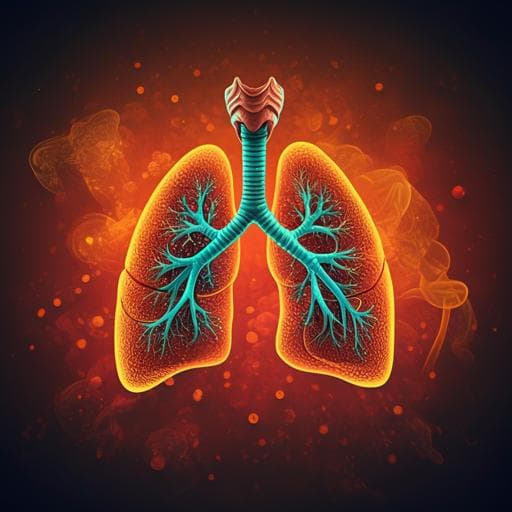
Environmental Studies and Forestry
Wildfire smoke impacts respiratory health more than fine particles from other sources: observational evidence from Southern California
R. Aguilera, T. Corringham, et al.
Wildfires are becoming more frequent and damaging, releasing hazardous PM2.5 particles that significantly impact respiratory health. This pivotal study by Rosana Aguilera, Thomas Corringham, Alexander Gershunov, and Tarik Benmarhnia reveals that PM2.5 from wildfires leads to higher rates of respiratory hospitalizations compared to PM2.5 from other sources. This research underscores the critical need for tailored air quality policies.
~3 min • Beginner • English
Introduction
The study investigates whether PM2.5 from wildfire smoke is more harmful to respiratory health than PM2.5 from non-wildfire sources. Although overall PM2.5 levels have declined in the United States, wildfire-related PM2.5 is projected to increase with climate change, with episodic spikes that can exceed regulatory thresholds. Current air quality standards implicitly assume uniform toxicity across PM2.5 sources, despite emerging evidence of differential toxicity. Southern California provides a natural laboratory due to Santa Ana winds that drive large, smoke-transporting wildfires predominantly in autumn through spring. The purpose is to isolate wildfire-specific PM2.5 and quantify its causal impact on respiratory hospitalizations at fine spatial (ZIP code) and temporal (daily) resolution over a long period.
Literature Review
Prior toxicological work indicates wildfire PM2.5 may have higher oxidative potential and induce greater inflammation and oxidative stress than urban ambient PM, likely due to composition (higher organic and elemental carbon, polar organics, PAHs) and combustion conditions. In vivo and in vitro studies have shown altered macrophage function and increased inflammatory responses with wildfire smoke exposure, with estimates of 3–4 times higher toxicity than comparable ambient PM doses. Epidemiological studies have linked wildfire smoke to exacerbations of respiratory and some cardiovascular outcomes, but many analyses have focused on single events or relied on computationally intensive chemical transport models, often at coarser spatial units (e.g., county level) and limited durations. One large study of older adults across the Western US reported increased respiratory admissions on high wildfire PM2.5 days but lacked fine spatial detail. There is a recognized need to separate wildfire-specific PM2.5 from non-smoke PM2.5 to accurately assess health risks.
Methodology
Study area and period: 696 ZIP codes in the Southern California Santa Ana wind (SAW) domain from 1999–2012, excluding June–August. Outcomes: Daily respiratory hospital admissions (ICD-9 460–519; asthma, COPD, pneumonia, interstitial lung disease) from California OSHPD, aggregated to ZIP code-day and converted to rates per 100,000 population. Exposure: Daily ZIP code-specific PM2.5 (24-h means) from EPA AQS ground monitors within 20 km of population-weighted ZIP centroids, interpolated using inverse distance weighting (IDW). PM2.5 represents total from all sources. PM2.5 data were available for 578 ZIP codes with varying missingness (mean 33%, median 15%). Wildfire exposure definitions (two): (1) Fire upwind + strong SAW: a ZIP is considered exposed when its centroid lies within 160 km of a wildfire perimeter centroid and within an angle window (approximately −10° to 120° capturing northeasterly SAW flow), on days with strong SAWs per the daily Santa Ana Wind Regional Index (SAWRI) exceeding 3.06 m s−1 (median of positive SAWRI). (2) NOAA HMS smoke plumes intersecting ZIP polygons, combined with presence of a wildfire within 160 km, available from September 2005 onward; acknowledges HMS limitations (column smoke, not validated regionally). Weather covariates: Daily means of wind speed, temperature, humidity from NOAA NCEI ISD, IDW-interpolated to ZIP centroids. Analytical approaches to isolate wildfire-specific PM2.5: (i) Instrumental variable (IV) two-stage least squares: First-stage regress PM2.5 on a joint instrument combining upwind wildfire occurrence and strong SAWs; second-stage regress respiratory admission rates on fitted PM2.5, controlling for flu admissions, weather, day-of-week, month, linear time trend, and ZIP fixed effects. The approach estimates a local average treatment effect under standard IV assumptions (relevance, exclusion, monotonicity). (ii) Spatio-temporal multiple imputation: Identify smoke-exposed ZIP-days (by exposure definition). Use cubic spline interpolation (imputeTS in R) over time to impute counterfactual non-smoke PM2.5 for those exposed days (without filling originally missing PM2.5). Wildfire-specific PM2.5 is the difference between observed total PM2.5 and imputed non-smoke PM2.5 (set negatives to zero if applicable). Regress respiratory rates on wildfire-specific PM2.5 with the same controls and ZIP fixed effects. (iii) Interaction model: ZIP fixed-effects Poisson regression with an interaction between PM2.5 and a wildfire-exposure indicator; includes controls (flu, wind, temperature, humidity, day-of-week, month, linear trend) and log population offset. The non-wildfire PM2.5 effect is the main PM2.5 coefficient; wildfire-specific effect is the sum of the main and interaction terms; marginal effects derived with the delta method. (iv) Seasonal interpolation (per Lipner et al.): For smoke-exposed ZIP-days, estimate provisional daily non-smoke PM2.5 using IDW based only on non-exposed ZIP-days; compute seasonal (3-month) background as median non-smoke PM2.5 per grid cell; wildfire PM2.5 equals observed minus seasonal background (negative differences set to zero); remaining component defines daily non-smoke PM2.5. Regress respiratory rates on wildfire-specific PM2.5 with the same controls. Software: ArcGIS 10.5, R 3.5.1 (plm, imputeTS), Stata 16.
Key Findings
Across eight combinations of methods and exposure definitions, a 10 µg m−3 increase in wildfire-specific PM2.5 was associated with increases in respiratory hospitalizations ranging from approximately 1.3% up to 10%. Using the spatio-temporal imputation approach with the fire upwind + strong SAW exposure definition, the estimated increase was 10.0% (95% CI: 3.5–16.5) per 10 µg m−3. For comparison, aggregated PM2.5 from all sources was associated with a 0.76% (95% CI: 0.42–1.1) increase per 10 µg m−3, and non-wildfire PM2.5 was associated with increases between roughly 0.67% and 1.3% per 10 µg m−3 depending on method. Confidence intervals for wildfire-specific estimates were wide but consistently indicated larger effects than for non-smoke PM2.5. Descriptive context: Mean daily respiratory admissions rate was 1.85 per 100,000 people; mean PM2.5 was 15.6 µg m−3 (IQR 9.2 µg m−3). Seasonal patterns showed SAW activity peaking November–January, higher PM2.5 in late fall/winter, and admission peaks in winter. Case studies (e.g., October 2007 fires) showed general agreement across wildfire-specific PM2.5 estimation methods during extreme events.
Discussion
The analysis directly addresses whether wildfire-derived PM2.5 is more harmful than PM2.5 from other sources by isolating wildfire-specific exposures with multiple, independent methods and comparing effect sizes within the same modeling framework and controls. The consistently higher risks associated with wildfire-specific PM2.5, even at similar mass concentrations, support the hypothesis of differential toxicity by source. Mechanistic evidence suggests wildfire smoke composition and combustion conditions increase oxidative potential and inflammatory responses, aligning with the stronger epidemiological associations observed. Public health implications are substantial because wildfires can rapidly elevate PM2.5 to hazardous levels, disproportionately affecting vulnerable groups such as children and older adults. Policy relevance: current PM2.5 regulations that assume uniform toxicity may underestimate health risks during wildfire events; incorporating source-specific considerations could improve risk management. The findings are salient for regions with wind-driven wildfires and are increasingly relevant under climate change scenarios projecting more frequent and severe wildfire smoke episodes in Southern California and similar environments.
Conclusion
Using four complementary approaches and two exposure definitions at daily ZIP code resolution over 14 years, the study demonstrates that wildfire-specific PM2.5 is substantially more harmful to respiratory health than PM2.5 from other sources, with up to ten-fold larger increases in hospitalizations per 10 µg m−3. These results argue for air quality and public health policies that recognize source-specific PM2.5 toxicity and prepare for episodic smoke exposures. Future research should refine exposure assessment (including validation and vertical distribution of smoke plumes), evaluate lagged and cumulative effects, isolate wildfire-specific ozone impacts, and examine differential toxicity across ecosystems, fuel types, and combustion conditions. Extending analyses beyond the SAW season and improving individual-level exposure metrics could further enhance the precision and generalizability of estimates.
Limitations
Exposure assessment relied on patient home ZIP code and community-level PM2.5, which may not reflect individual exposures. HMS smoke plumes are based on visible satellite imagery, cannot distinguish ground-level from elevated smoke, and are not systematically validated, leading to potential exposure misclassification. The upwind fire plus strong SAW definition focuses on SAW-driven events and could misclassify smoke and non-smoke days; smoke plumes within 160 km may include some non-SAW fires. Summer months were excluded due to dormant SAWs, limiting seasonal generalizability. Models did not include lagged exposure effects. Potential confounding by wildfire-related ozone was not explicitly modeled, although literature suggests PM2.5 effects persist when adjusting for ozone; future work should isolate ozone impacts. PM2.5 monitoring data had missingness and required interpolation, and wildfire-specific PM2.5 estimates from seasonal interpolation versus imputation can differ depending on background assumptions. Confidence intervals for wildfire-specific effect estimates were wide.
Related Publications
Explore these studies to deepen your understanding of the subject.







